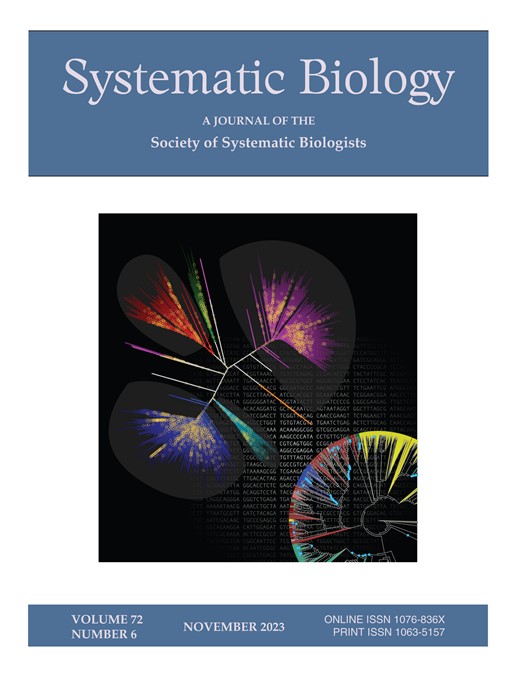最近,亚马逊地区复杂的物种形成由树松鼠的多层基因组分析揭示
IF 6.1
1区 生物学
Q1 EVOLUTIONARY BIOLOGY
引用次数: 0
摘要
物种多样性的准确估计对所有生物多样性研究都至关重要。划分物种和理解物种形成的潜在过程也是系统生物学的核心组成部分,它构建了我们对产生生物多样性的进化机制的理解。南美洲树松鼠(Guerlinguetus属)是一种重要的哺乳动物,分布广泛,在世界上最脆弱和最受威胁的生态系统之一——南美洲热带雨林中,它们对树木种子的捕食和传播至关重要。我们获得了基因组数据(超保守元件和单核苷酸多态性),以探索关于该属物种限制的其他假设,并阐明在大陆尺度和动态进化的景观上最近和快速的物种形成。通过将精细群体遗传分析与定量分子物种划分方法相结合的多层基因组方法,我们观察到(i)与经典形态修正和线粒体物种划分相比,Guerlinguetus最可能的物种数量为6个;物种关系的不一致性仍然存在,这可能是对东亚马逊低地发生的种群迁移和基因流动的反应,或者是对极快的连续物种形成事件的反应;(iii)有效迁移面检测到与主要亚马逊河流系统和圭亚那地盾山脉相关的重要地理障碍。总之,我们在Guerlinguetus身上发现了意想不到的更高的物种多样性,并证实了最近的发现,即亚马逊地区现存的物种多样性大多是年轻的,可以追溯到第四纪。我们还加强了关于河流和气候驱动的森林动态在触发亚马逊物种形成中的作用的长期建立的假设。[基因流动;Guerlinguetus;迁移;mito-nuclear不整合;Neotropics;定量物种划分;科;ultraconserved元素)本文章由计算机程序翻译,如有差异,请以英文原文为准。
Recent, Intricate Speciation in Amazonia Uncovered by a Multilayered Genomic Analysis of Tree Squirrels
Accurate estimates of species diversity are essential for all biodiversity research. Delimiting species and understanding the underlying processes of speciation are also central components of systematic biology that frame our comprehension of the evolutionary mechanisms generating biodiversity. The South American tree squirrels (genus Guerlinguetus) are keystone mammals, widely distributed, that are critical in tree-seed predation and dispersal in one of the most fragile and threated ecosystems of the world, the tropical rainforests of South America. We obtained genomic data (ultraconserved elements and single nucleotide polymorphisms) to explore alternative hypotheses on species limits of this genus and to clarify recent and rapid speciation on continental-scale and dynamically evolving landscapes. Using a multilayered genomic approach that integrates fine-scale population genetic analyses with quantitative molecular species delimitation methods, we observed that (i) the most likely number of species within Guerlinguetus is six, contrasting with both classic morphological revision and mitochondrial species delimitation; (ii) incongruencies in species relationships still persist, which might be a response to population migration and gene flow taking place in the lowlands of eastern Amazonia and/or to the extremely rapid successive speciation events; and (iii) effective migration surfaces detected important geographic barriers associated with the major Amazonian riverine systems and the mountain ranges of the Guiana Shield. In conclusion, we uncovered unexpected and higher species diversity on Guerlinguetus and corroborate recent findings suggesting that much of the extant species-level diversity in Amazonia is young, dating back to the Quaternary. We also reinforce long-established hypotheses on the role of rivers and climate-driven forest dynamics in triggering Amazonian speciation. [gene flow; Guerlinguetus; migration; mito-nuclear discordance; Neotropics; quantitative species delimitation; Sciuridae; ultraconserved elements]
求助全文
通过发布文献求助,成功后即可免费获取论文全文。
去求助
来源期刊

Systematic Biology
生物-进化生物学
CiteScore
13.00
自引率
7.70%
发文量
70
审稿时长
6-12 weeks
期刊介绍:
Systematic Biology is the bimonthly journal of the Society of Systematic Biologists. Papers for the journal are original contributions to the theory, principles, and methods of systematics as well as phylogeny, evolution, morphology, biogeography, paleontology, genetics, and the classification of all living things. A Points of View section offers a forum for discussion, while book reviews and announcements of general interest are also featured.
 求助内容:
求助内容: 应助结果提醒方式:
应助结果提醒方式:


